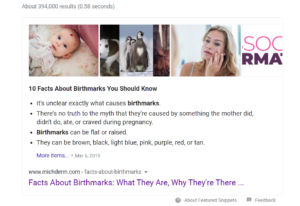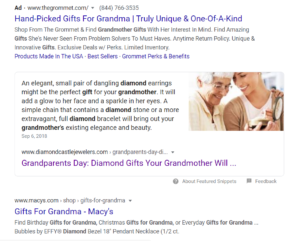“If I accept this stimulus check due to the coronavirus pandemic, will it be considered income and therefore prohibit me from filing for bankruptcy?”
Realizing that many individuals in the state were asking themselves and attorneys that exact question, we set out to answer their concerns in a blog that we posted on the website of one of our clients.
In less than one month from the day that blog was posted, the post contributed to 40% of new visits to this law firm’s website.
This is only one example of hundreds that showcases how Basso can help drive traffic to your website with relevant, timely, and wisely crafted blogs that are posted on a regular basis.
How Basso Helps Your Business with Effective Blogging Techniques
The concept of a blog has come a long way since it first came about in the 1990s. Back then, blogs were considered “journal” entries. Some blogs detailed serious stories about dramatic events, others offered DIY home repair tips, some were jokes of the day, and so on.
That idea still exists to a certain point, but blogs have evolved into something much bigger. Today, a blog channel is no longer an optional addition or something you do for fun. Today, it’s a must.
If you haven’t yet experienced the power of blogging, here are 7 reasons why an effective blog channel is a bedrock of your marketing strategy:
1. It’s crucial to keep your website updated. Doing so enhances your search engine rankings and gives your site credibility with the search engines.
2. It keeps your prospects, leads, and existing customers coming back for more.
3. The blog channel gives viewers something to read on your site, which increases the time they spend on the site. The average time spent reading a blog post is 37 seconds. If you manage to keep up with that statistic, that’s good, but it’s even better to keep viewers there longer. When you do, the search engines recognize that your site is providing website viewers with something they want to see.
4. Blogs lead prospects further into the sales funnel through calls to action that are included with each blog post.
5. Each blog has a different theme and a different main keyword. The more blogs you have on your site that are tailored to what your target audience is searching, the more likely you are to be able to answer their questions. In other words, no matter what they search, your site can have the answer if your blog channel is comprehensive enough regarding your niche in the industry. If the search engines believe you are the best source of information, the higher your posts are likely to rank.
6. With analytics tools, you can generally track visits to your website and recognize what types of posts visitors were most interested in reading.
7. Regularly updating blog posts gives you a competitive edge. If your competitors are regularly posting on their site, you need to not only keep up with them, but outdo them.

Paid vs. Organic vs. Direct Traffic: Why You Need All Three
In today’s market, taking advantage of Google Ads, Facebook Ads, and other paid advertising opportunities is a key to remaining competitive. However, that’s only about a third of what you need.
You also need organic traffic, which essentially means website visits through natural means. Unlike paid advertisements, which are temporary, focusing on enhancing your organic rankings benefits your brand indefinitely. Those paid advertisements will only be there as long as you pay for them, but blog posts are more like fine wine that gets better with age; blogs can stay on your site for years and only help you gain traction over time as each one becomes a piece of the bigger picture.
Blogs are one of the top ways to draw in organic traffic. In fact, without blogs, you’re basically relying on advertisements and direct traffic, the third and most desirable piece of the pie. Direct traffic is when people know you and come directly to your website by choice, not by clicking on a link in a social media post or advertisement.
By the way, let’s go back to #2 in the list above. Go ahead. We’ll wait. … You see, if your prospects know you and trust you and you regularly give them answers to their questions, that’s a perfect recipe for higher direct traffic.
To give you another example that demonstrates our successes for our clients, listen to this one:
We analyzed the top 25 pages bringing traffic to a specific medical client’s website from January through the beginning of May of this year.

Of these 25 landing pages, 10 were blog posts, with a blog discussing birthmarks coming in at the No. 3 spot. Of that number, more than 94 percent of the sessions were new users, also a highly desirable result to have.
This specific blog was posted on the client’s site in March 2019, and it has consistently been one of the highest-ranking landing pages since then. In fact, a Google search of “Facts about Birthmarks” returns results with this blog at the elusive but enviable featured snippet.
Do the Numbers Really Count?
With the above being said regarding the need for both paid and organic marketing strategies, here’s something many people tend to overlook: Only in terms of blogs, it’s about quality of traffic over quantity of traffic.
If you can get thousands of people to read your blog, that’s excellent. It’s a great way to enhance domain authority and brand awareness. However, it’s more important that the right people see the posts.
For instance, let’s say you own an auto repair shop. If you write a blog providing a recipe for your favorite chocolate cake, well, you might get a lot of traffic because that’s a fun blog to read, right? Who doesn’t love chocolate cake?
However, you’re a mechanic, not a baker. So instead, you write a blog about why it’s important to rotate your tires regularly. You might not get quite as much traffic, but who do you think will actually see that post?
Someone who searched something to the effect of “best mechanic for tire rotations” of course! That’s the person you really want to see your blog.

And here’s a perfect example of this particular point:
Would you consider buying a diamond gift for your grandmother? If so, the first thing you might do is search online for “diamond gifts for grandma.” Go ahead and try that one out now and see what you get. We’ll wait again. … Are you back? OK, great. The featured snippet you likely saw or the blog that came up in the No. 1 spot – before even Pinterest and Macy’s – yep, we did that. We posted it on this client’s site more than two years ago, and it’s still holding rank.
Does it really matter how many people see the blog? It does to a point as we’ve mentioned, but not that much as long as you – the wonderful grandson or granddaughter that you are – saw the blog and considered going to that jewelry store.
The bottom line is that the most effective blog channels give your specific audience what it wants, which increases your credibility with the search engines.
You also need all three pieces of the puzzle — paid, organic, and direct traffic — for a more comprehensive marketing strategy. Our team has expertise in all these facets and more, so we can help your business in every aspect.
Want to know more? See our website or call us! If you need marketing assistance, we’ve got your back.
